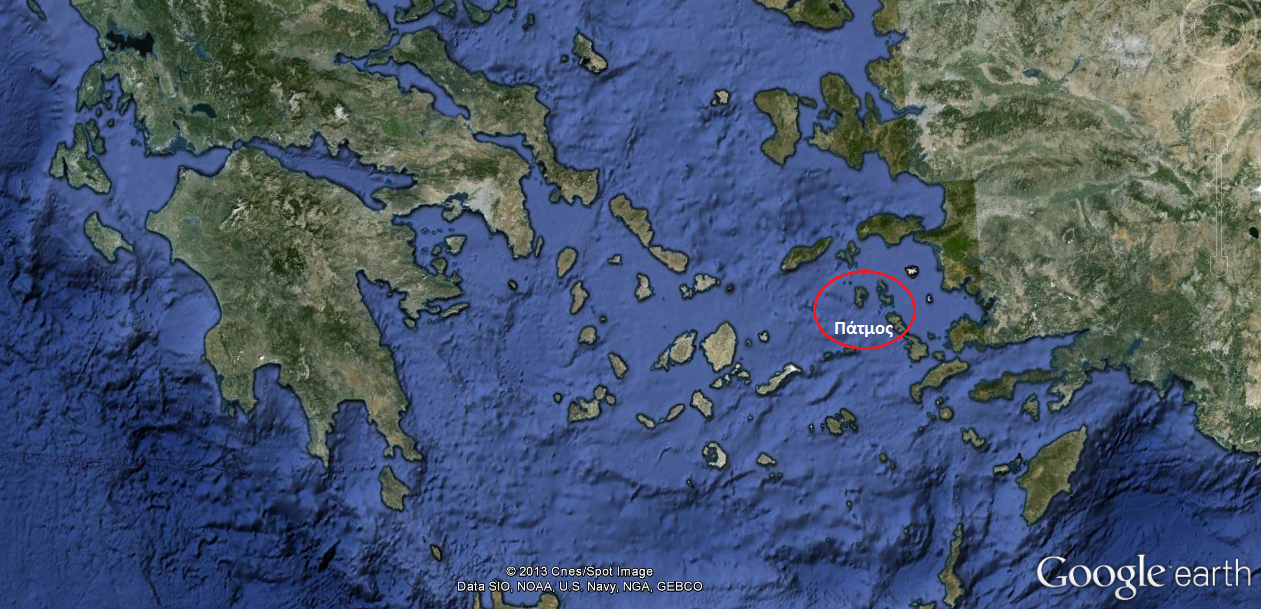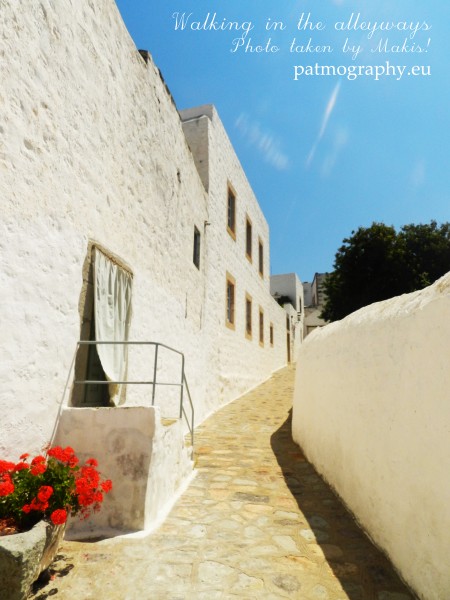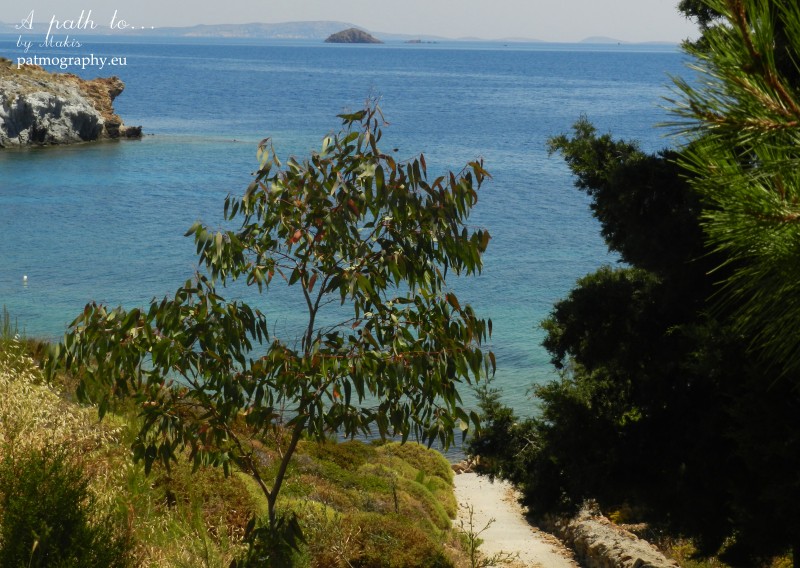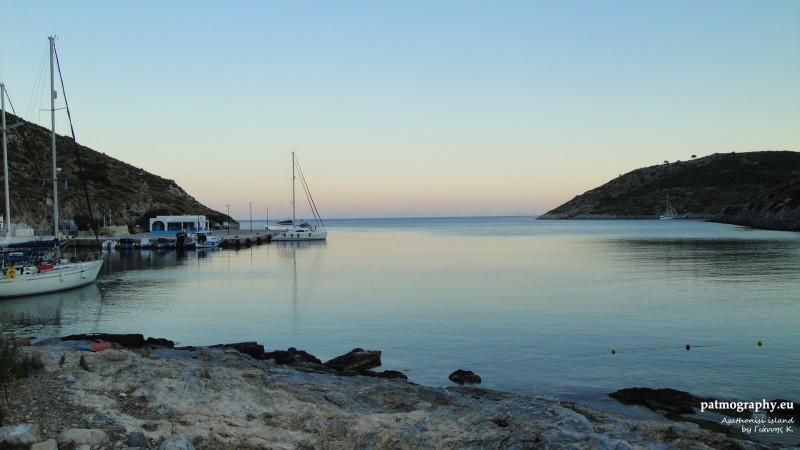Patmos (Greek, Πάτμος; Italian: Patmo) is a small Greek island in the Aegean Sea. One of the northernmost islands of the Dodecanese complex, it has a population of 2,998 and an area of 34.05 km2 (13.15 sq mi). The highest point is Profitis Ilias, 269 metres (883 ft) above sea level. The Municipality of Patmos, which includes the offshore islands of Arkoi (pop. 44), Marathos (pop. 5), and several uninhabited islets, has a total population of 3,047 (2011 census) and a combined land area of 45.039 square kilometres (17.390 sq mi). It is part of the Kalymnos regional unit.

Patmos’ main communities are Chora (the capital city), and Skala, the only commercial port. Other settlements are Grikou and Kampos. The churches and communities on Patmos are of the Eastern Orthodox tradition. In 1999, the island’s historic center Chora, along with the Monastery of Saint John the Theologian and the Cave of the Apocalypse, were declared World Heritage Sites by UNESCO. The monastery was founded by Saint Christodulos. Patmos is also home to the Patmian School, a notable Greek seminary.
Patmos is mentioned in the Christian scriptural Book of Revelation. The book’s introduction states that its author, John, was on Patmos when he was given (and recorded) a vision from Jesus. Early Christian tradition identified this writer John of Patmos as John the Apostle, though some modern scholars are uncertain. As such, Patmos is a destination for Christian pilgrimage. Visitors can see the cave where John is said to have received his Revelation (the Cave of the Apocalypse), and several monasteries on the island are dedicated to Saint John.
Forbes in a 2009 research has named Patmos as Europe’s Most Idyllic Place to live, due to the fact that “Patmos has evolved over the centuries but has not lost its air of quiet tranquility, which is one reason why people that know it return again and again.”
History
 The earliest remains of human settlements date to the Middle Bronze Age (c. 2000 BC). They consist of pottery shards from Kastelli, the most important archaeological site so far identified.
The earliest remains of human settlements date to the Middle Bronze Age (c. 2000 BC). They consist of pottery shards from Kastelli, the most important archaeological site so far identified.
Patmos is seldom mentioned by ancient writers. Therefore very little can be conjectured about the earliest inhabitants. In the Classical period, the Patmians prefer to identify themselves as Dorians descending from the families of Argos, Sparta and Epidaurus, further mingling with people of Ionian ancestry.
Judging from archaeological finds, Kastelli continued to play an important role on the island throughout the Ancient Greek period (c. 750 BC-323 BC).
During the 3rd century BC, in the Hellenistic period, the settlement of Patmos acquired the form of an acropolis with an improved defence through a fortification wall and towers.
Patmos is mentioned in the Christian scriptural Book of Revelation. The book’s introduction states that its author, John, was on Patmos when he was given (and recorded) a vision from Jesus. Early Christian tradition identified this writer John of Patmos as John the Apostle.[7] As such, Patmos is a destination for Christian pilgrimage. Visitors can see the cave where John is said to have received his Revelation (the Cave of the Apocalypse), and several monasteries on the island are dedicated to Saint John.
After the death of John of Patmos, possibly around 100, a number of Early Christian basilicas were erected on Patmos. Among these was a Grand Royal Basilica in honour of Saint John, built c. 300-350 at the location where the Monastery of Saint John the Theologian stands today.
Early Christian life on Patmos, however, barely survived Muslim raids from the 7th to the 9th century. During this period, the Grand Basilica was destroyed. In the 11th century, the Byzantine Emperor Alexios I Komnenos gave Christodoulos the complete authority over the island of Patmos, as well as the permission to build a monastery on the island. The construction of the monastery started in 1101.
9th century. During this period, the Grand Basilica was destroyed. In the 11th century, the Byzantine Emperor Alexios I Komnenos gave Christodoulos the complete authority over the island of Patmos, as well as the permission to build a monastery on the island. The construction of the monastery started in 1101.
Population was expanded by infusions of Byzantine immigrants fleeing the Fall of Constantinople in 1453, and Cretan immigrants fleeing the fall of Candia in 1669.
The island was controlled by the Ottoman Empire for many years, but it enjoyed certain privileges, mostly related to tax-free trade by the monastery as certified by Ottoman imperial documents held in the Library.
In 1912, in connection with the Turco-Italian War, the Italians occupied all the islands of the Dodecanese, including Patmos. The Italians remained there until 1943, when Nazi Germany took over the island.
In 1945, the Germans left and the island of Patmos remained autonomous until 1948, when it, together with the rest of the Dodecanese Islands, joined the independent Greece.[8]
The birth of Patmos according to Greek mythology
According to a legend within the Greek mythology, the island’s original name was “Letois,” after the goddess Artemis, daughter of Leto. It was believed that Patmos came into existence thanks to her divine intervention. Mythology tells of how Patmos existed as an island at the bottom of the sea.
 Deer-huntress Artemis frequently paid visits to Caria, the mainland across the shore from Patmos, where she had a shrine on Mount Latmos. There, she used to meet up with the moon goddess Selene, who cast her light on the ocean, revealing the sunken island of Patmos.
Deer-huntress Artemis frequently paid visits to Caria, the mainland across the shore from Patmos, where she had a shrine on Mount Latmos. There, she used to meet up with the moon goddess Selene, who cast her light on the ocean, revealing the sunken island of Patmos.
Selene was always trying to get Artemis to bring the sunken island to the surface and, hence, to life. Selene finally convinced Artemis, who, in turn, elicited her brother Apollo’s help, in order to persuade Zeus to allow the island to arise from the sea.
Zeus agreed, and the island emerged from the water. The Sun dried up the land and brought life to it. Gradually, inhabitants from the surrounding areas, including Mount Latmos, settled on the island and named it “Letois” in honour of Artemis.[9]
Geography
Patmos is situated off the west-coast of Turkey and the continent of Asia. It is one of the northernmost islands of the Dodecanese complex. It is further west than its nearby neighboring islands.
It contains an area of 34.05 km2 (13.15 sq mi). The highest point is Profitis Ilias, 269 metres (883 ft) above sea level.
Patmos’ main communities are Chora (the capital city), and Skala, the only commercial port. Other settlements are Grikou and Kampos.
For emergencies, Patmos has a medical center, with several medical doctors on the premises. When residents require hospitalization beyond the first aid care, they are airlifted out of the island by helicopter (on emergencies) to nearby ones or, if the weather permits, they are transported by the ferry
